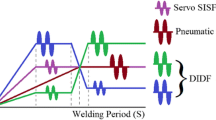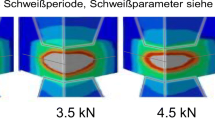Abstract
In this experimental study, the carbon steel welds are investigated for distinctive changes between the pneumatic- and servo-based electrode actuation. Also, two welding conditions, and the name of schemes, are introduced, as to distinguish the weld formation with respect to its common process variants. A C-typed body frame of spot welding machine (75 kVA) is employed to undertake the entire experiments. Initially, the pneumatic-based electrode actuating system is used to weld the carbon steels under single current and single force (SISF) welding scheme and later, the electrode actuation system was transformed into a servo-based system. With the servo-based system, the SISF and dual current and dual force (DIDF) welding schemes are both carried out to distinguish the welds formation. Eventually, the welded samples underwent the tensile test, hardness test, post-crack pattern recognition, and metallurgical study. Results have shown that the DIDF welding scheme is much better than the SISF welding scheme because the servo-based system performs well than the pneumatic-based system in producing force consistencies. In other words, the force profiles influence the fusion process directly which affects the heat generation as well as the heat diffusion.
Similar content being viewed by others
References
Arvinthan A, Nachimani C (2011) Analysis of spot welds growth on carbon and stainless steel. Weld J 90:143–147
Aravinthan A, Nachimani C (2011) A metallurgical study of spot welds growth on carbon steel with 1 mm and 2 mm thicknesses. J Inst Eng 72(4):32–36
Charde N (2013) Analyzing the force and current profiles using pneumatic and servo based electrode actuation system for resistance spot welding. Caspian J Appl Sci Res 2(8):38–45
Dursun O (2008) An effect of weld current and weld atmosphere on the resistance spot weld ability of 304L austenitic stainless steel. Mater Des 29:597–603
Feramuz K (2009) The effect of process parameter on the properties of spot welded cold deformed AISI304 grade austenitic stainless steel. J Mater Process Technol 209:4011–4019
Pouranvari M, Marashib SPH (2013) Failure mode transition in AHSS resistance spot welds, part I: controlling factors. Mater Sci Eng A 528:8337–8343
Darwish SM, Al-Samhan AM (2004) Peel and shear strength of spot-welded and weld-bonded dissimilar thickness joints. J Mater Process Technol 147:63–78
Kent P, Von M, Henning EN (2000) Comparison of peel bond and shear tensile test methods for needle punched geo synthetic clay liners. Geotext Geomembr 18:203–214
Triyono, Jamasri, Ilman MN, Soekrisno R (2009) Comparative study of fatigue assessment methods with and without considering residual stress on resistance spot-welded unequal sheet thickness stainless steel. Int J Eng Technol 11:456–462
Dancette S, Fabregue D, Massardier V, Merlin J, Dupuy T, Bouzekri M (2012) Investigation of the tensile shear fracture of advanced high strength steel spot welds. Eng Fail Anal 25:112–122
Nordberg H (2005) Fatigue properties of stainless steel lap joints. SAE Trans J Mater Manuf 114:675s–690s
Bayraktar E, Moiron J, Kaplan D (2006) Effect of welding conditions on the formability characteristics of thin sheet steels: mechanical and metallurgical effects. J Mater Process Technol 175:20–26
Senkara J, Zhang H, Hu SJ (2004) Expulsion prediction in resistance spot welding. Weld J 83:123s–132s
Marashi P (2008) Microstructure and failure behavior of dissimilar resistance spot welds between low carbon galvanized and austenitic stainless steels. Mater Sci Eng A 480:175–180
Jamasri MN (2011) Corrosion fatigue behavior of RSW welded dissimilar metal welds between carbon steel and austenitic stainless steels with different thickness. Procedia Eng 10:649–654
Tang H, Hou W, Hu SJ (2002) Forging force in resistance spot welding. Proc Inst Mech Eng B J Eng Manuf 216:957–965
Isaev AP (2006) A method for modeling the pneumatic drive and load carrying structure of resistance spot welding machines. Svarochnoe Proizvodstvo 59(3):18–25
Chang BH, Du D, Sui B (2006) Effect of forging force on fatigue behavior of spot welded joints of aluminum alloy 5182. J Manuf Sci Eng 1:345–352
Marashi P, Pouranvari M, Amirabdollahian S (2008) Microstructure and failure behaviour of dissimilar resistance spot welds between low carbon galvanized and austenitic stainless steels. Mater Sci Eng 480:175–180
Jamasri MN, Ilman R, Triyono S (2011) Corrosion fatigue behaviour of RSW dissimilar metal welds between carbon steel and austenitic stainless steel with different thickness. Procedia Eng 10:649–654
Yang Y, Qu X, Luo Y, Yang A (2011) Effect of resistance spot welding parameters on the austenitic stainless steel 304 grade by using 23 factorial designs. Adv Mater Res 216:666–670
Mehdi MH, Abadi A, Pouranvari M (2008) Correlation between macro/micro structure and mechanical properties of dissimilar RSW of AISI 304 austenitic stainless steel and AISI 1008 low carbon steel. Sci Pap AssocMetall Eng Serbia 2:56–63
Author information
Authors and Affiliations
Corresponding author
Rights and permissions
About this article
Cite this article
Charde, N. Techniques for the improvement of carbon steels welds: under the SISF and DIDF welding schemes using pneumatic- and servo-based electrode actuating systems in resistance spot welding. Int J Adv Manuf Technol 89, 3161–3168 (2017). https://doi.org/10.1007/s00170-016-9232-x
Received:
Accepted:
Published:
Issue Date:
DOI: https://doi.org/10.1007/s00170-016-9232-x




